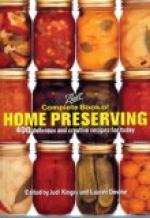The stove for laundry use may be either gas, oil, or coal, the latter being considered the most economical of fuel, while it often comes in very handy in the preparation of foods which require long stewing or simmering. The wringer should be of medium size, either wooden or iron-framed, the former having the advantage of lightness, the latter of strength. The screws must be loosened after each washing and thoroughly dried. Any particles of rust can be removed with kerosene. The following list gives a very fair idea of the essentials of the well-furnished laundry, and their cost:
2 paper tubs................................ $2.40 1 wringer................................... 3.75 1 block-tin boiler with copper bottom....... 2.15 1 washboard................................. .25 1 paper pail................................ .25 1 long-handled starch spoon................. .08 1 long-handled dipper....................... .12 1 set clothes bars ......................... .95 1 wash bench ............................... .75 1 fifty-foot hemp line...................... .20 1 ironing board, or ) ...................... .95 1 skirt-board ) ...................... .50 3 Mrs. Potts’ nickel-plated irons........... 2.85 1 sleeve and ruffle iron.................... .35 1 iron rest................................. .08 1 clothes stick............................. .10 1 clothes basket............................ .80 5 dozen clothespins......................... .10 2 pieces beeswax............................ .05
IRONS AND HOLDERS
If the ordinary flatirons are preferred, they may be had at 5 cents a pound. They require, of course, the use of a good, stout holder, asbestos covered with ticking affording the best protection to the hand. Slip cases are nice for use of this kind, as they can be taken off and washed. Pad the ironing board with Canton flannel or a coarse blanket, then draw tightly over it a white cotton cloth and fasten on the under side. The padding must be absolutely smooth and without a wrinkle. And there must be a piece of cheesecloth with which to wipe possible dust from the line, a scrubbing brush for the cleaning-up process which closes the washing drama, and the various preparations used to remove stains and assist in the cleansing of the linen and clothing—borax, starch, bluing, ammonia, oxalic acid, soda, kerosene, turpentine, etc.
PREPARING THE “WASH”
With all the “properties” in readiness, the fire burning well, and plenty of hot water to draw upon, the curtain rises on the laundress sorting the flannels, table linen, fine underwear, towels, and bed linen, colored clothes and stockings into separate piles, each to be disposed of in its turn, from fine articles down through to coarse, laying aside any which have stains. These stains she removes in a variety of ways, according to their nature, but removed they must be before going into the tub, where, in most instances, the hot suds will render them ineradicable, although it has the reverse effect on dirt. It is a wise plan to mark, with a black thread before putting in the wash, any stains which are apt to be overlooked by the laundress, and those on large pieces, such as bedspreads.




